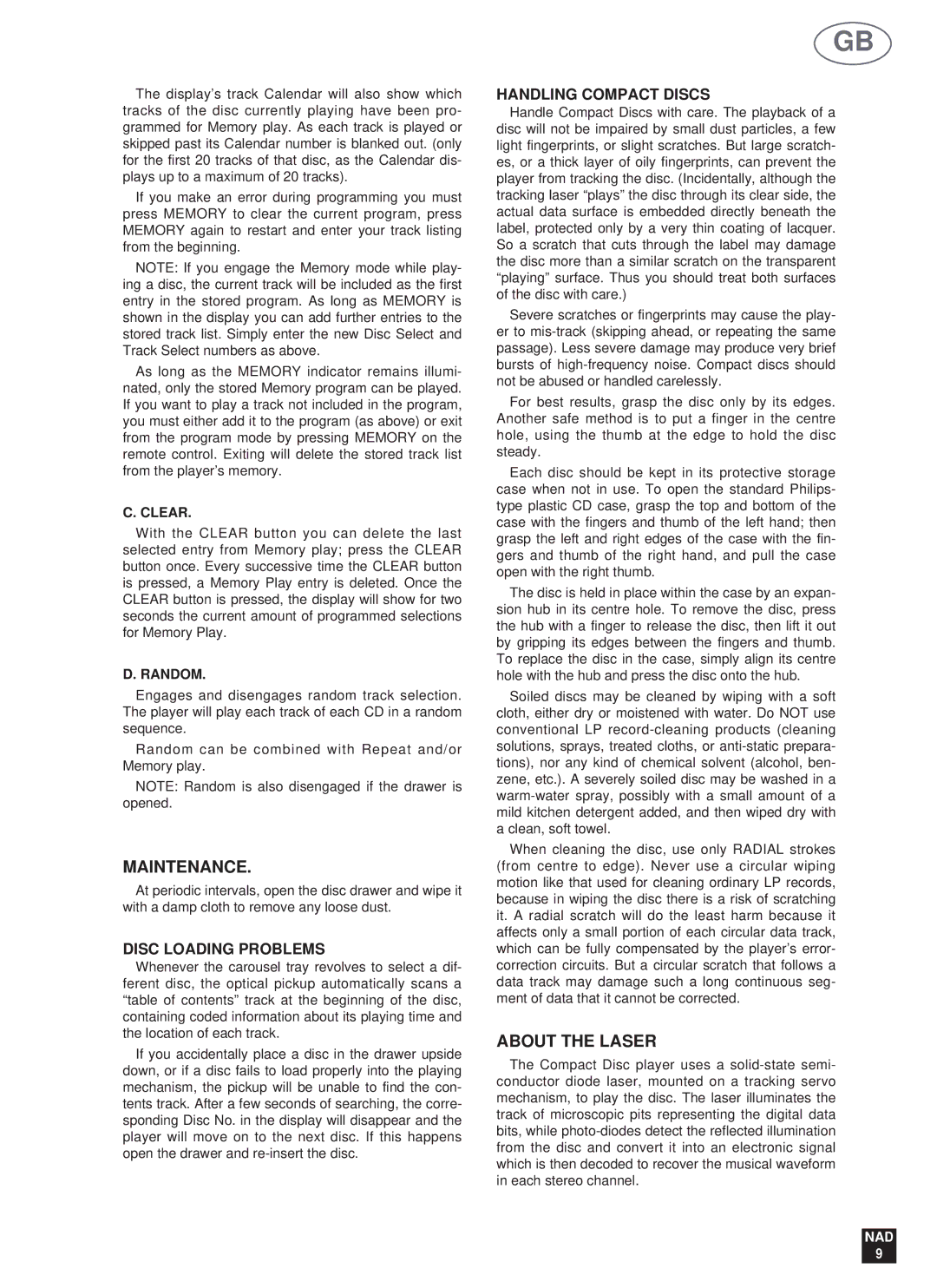The display’s track Calendar will also show which tracks of the disc currently playing have been pro- grammed for Memory play. As each track is played or skipped past its Calendar number is blanked out. (only for the first 20 tracks of that disc, as the Calendar dis- plays up to a maximum of 20 tracks).
If you make an error during programming you must press MEMORY to clear the current program, press MEMORY again to restart and enter your track listing from the beginning.
NOTE: If you engage the Memory mode while play- ing a disc, the current track will be included as the first entry in the stored program. As long as MEMORY is shown in the display you can add further entries to the stored track list. Simply enter the new Disc Select and Track Select numbers as above.
As long as the MEMORY indicator remains illumi- nated, only the stored Memory program can be played. If you want to play a track not included in the program, you must either add it to the program (as above) or exit from the program mode by pressing MEMORY on the remote control. Exiting will delete the stored track list from the player’s memory.
C. CLEAR.
With the CLEAR button you can delete the last selected entry from Memory play; press the CLEAR button once. Every successive time the CLEAR button is pressed, a Memory Play entry is deleted. Once the CLEAR button is pressed, the display will show for two seconds the current amount of programmed selections for Memory Play.
D. RANDOM.
Engages and disengages random track selection. The player will play each track of each CD in a random sequence.
Random can be combined with Repeat and/or Memory play.
NOTE: Random is also disengaged if the drawer is opened.
MAINTENANCE.
At periodic intervals, open the disc drawer and wipe it with a damp cloth to remove any loose dust.
DISC LOADING PROBLEMS
Whenever the carousel tray revolves to select a dif- ferent disc, the optical pickup automatically scans a “table of contents” track at the beginning of the disc, containing coded information about its playing time and the location of each track.
If you accidentally place a disc in the drawer upside down, or if a disc fails to load properly into the playing mechanism, the pickup will be unable to find the con- tents track. After a few seconds of searching, the corre- sponding Disc No. in the display will disappear and the player will move on to the next disc. If this happens open the drawer and re-insert the disc.
GB
HANDLING COMPACT DISCS
Handle Compact Discs with care. The playback of a disc will not be impaired by small dust particles, a few light fingerprints, or slight scratches. But large scratch- es, or a thick layer of oily fingerprints, can prevent the player from tracking the disc. (Incidentally, although the tracking laser “plays” the disc through its clear side, the actual data surface is embedded directly beneath the label, protected only by a very thin coating of lacquer. So a scratch that cuts through the label may damage the disc more than a similar scratch on the transparent “playing” surface. Thus you should treat both surfaces of the disc with care.)
Severe scratches or fingerprints may cause the play- er to mis-track (skipping ahead, or repeating the same passage). Less severe damage may produce very brief bursts of high-frequency noise. Compact discs should not be abused or handled carelessly.
For best results, grasp the disc only by its edges. Another safe method is to put a finger in the centre hole, using the thumb at the edge to hold the disc steady.
Each disc should be kept in its protective storage case when not in use. To open the standard Philips- type plastic CD case, grasp the top and bottom of the case with the fingers and thumb of the left hand; then grasp the left and right edges of the case with the fin- gers and thumb of the right hand, and pull the case open with the right thumb.
The disc is held in place within the case by an expan- sion hub in its centre hole. To remove the disc, press the hub with a finger to release the disc, then lift it out by gripping its edges between the fingers and thumb. To replace the disc in the case, simply align its centre hole with the hub and press the disc onto the hub.
Soiled discs may be cleaned by wiping with a soft cloth, either dry or moistened with water. Do NOT use conventional LP record-cleaning products (cleaning solutions, sprays, treated cloths, or anti-static prepara- tions), nor any kind of chemical solvent (alcohol, ben- zene, etc.). A severely soiled disc may be washed in a warm-water spray, possibly with a small amount of a mild kitchen detergent added, and then wiped dry with a clean, soft towel.
When cleaning the disc, use only RADIAL strokes (from centre to edge). Never use a circular wiping motion like that used for cleaning ordinary LP records, because in wiping the disc there is a risk of scratching it. A radial scratch will do the least harm because it affects only a small portion of each circular data track, which can be fully compensated by the player’s error- correction circuits. But a circular scratch that follows a data track may damage such a long continuous seg- ment of data that it cannot be corrected.
ABOUT THE LASER
The Compact Disc player uses a solid-state semi- conductor diode laser, mounted on a tracking servo mechanism, to play the disc. The laser illuminates the track of microscopic pits representing the digital data bits, while photo-diodes detect the reflected illumination from the disc and convert it into an electronic signal which is then decoded to recover the musical waveform in each stereo channel.
NAD
9

